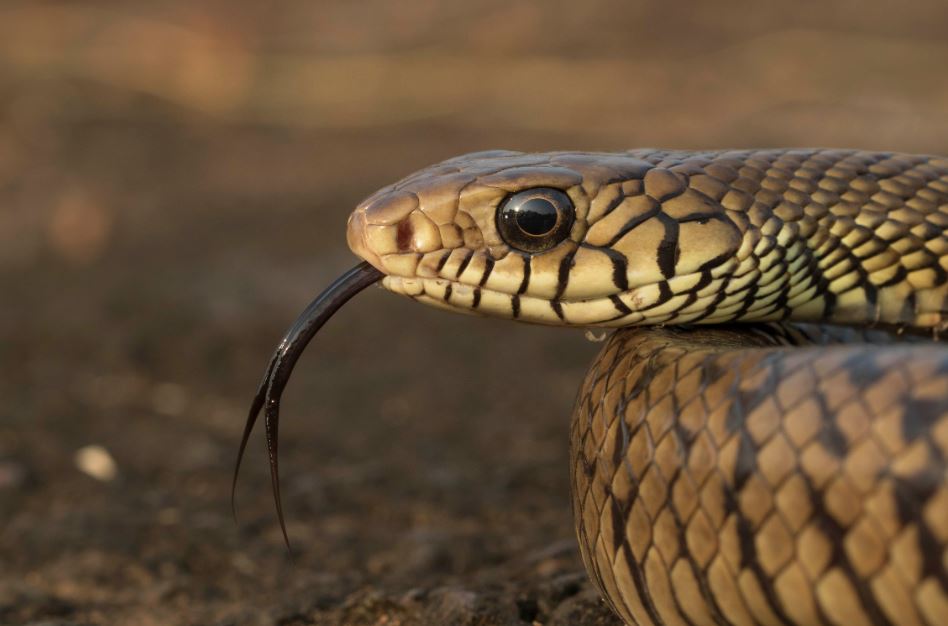Introduction
Indian rat snakes (Ptyas mucosa) are often misunderstood creatures, commonly mistaken for venomous snakes. However, these non-venomous reptiles play a crucial role in the agricultural ecosystem. They are natural pest controllers, particularly effective at keeping rodent populations in check. This article delves into the importance of Indian rat snakes for farmers, highlighting how these reptiles help maintain a balance in the ecosystem and reduce the reliance on chemical pesticides.
The Indian Rat Snake: A Brief Overview
The Indian rat snake is one of the largest snakes in the Indian subcontinent, reaching lengths of up to 8-10 feet. Despite their intimidating size, these snakes are harmless to humans. They are highly adaptable and are found in a variety of habitats, including forests, farmlands, and even urban areas. Their diet primarily consists of rodents, birds, and frogs, making them a vital part of the natural food chain.
The Rodent Problem in Agriculture
Rodents are a significant pest in agricultural areas. They cause extensive damage to crops by feeding on seeds, fruits, and stored grains. In addition to direct consumption, rodents contaminate food supplies with their droppings, leading to further economic losses for farmers. The traditional method of controlling rodents involves the use of chemical pesticides and traps, which can be costly and harmful to the environment.
Indian Rat Snakes as Natural Pest Controllers
Indian rat snakes are nature’s solution to the rodent problem. By preying on rodents, they help control the population of these pests in agricultural fields. A single Indian rat snake can consume a large number of rodents over its lifetime, significantly reducing the damage caused to crops. Unlike chemical pesticides, which can have detrimental effects on the environment and non-target species, rat snakes offer a sustainable and eco-friendly alternative.
Benefits of Indian Rat Snakes in Agriculture
- Cost-Effective Pest Control: By reducing the need for chemical pesticides, Indian rat snakes help farmers save money. Pesticides are not only expensive but also require repeated applications, adding to the overall cost of farming. Rat snakes, on the other hand, provide continuous pest control at no cost.
- Environmental Protection: The excessive use of chemical pesticides has led to soil degradation, water pollution, and a decline in biodiversity. Indian rat snakes help mitigate these issues by providing a natural method of pest control that does not harm the environment.
- Biodiversity Preservation: Indian rat snakes contribute to the preservation of biodiversity in agricultural landscapes. By controlling rodent populations, they help maintain the balance of the ecosystem, allowing other species to thrive.
- Reduced Crop Damage: With fewer rodents in the fields, crop damage is significantly reduced. This leads to higher yields and better quality produce, directly benefiting farmers’ income.
- Decreased Human-Wildlife Conflict: In areas where Indian rat snakes are abundant, the need for human intervention in rodent control decreases. This reduces the chances of human-wildlife conflicts, as farmers do not have to resort to harmful methods to protect their crops.
Challenges and Misconceptions
Despite their benefits, Indian rat snakes are often killed out of fear or due to the misconception that they are venomous. Public awareness campaigns and education are essential to dispel these myths and promote the coexistence of humans and snakes. Farmers, in particular, need to be educated about the benefits of these snakes and encouraged to protect them rather than kill them.
Another challenge is habitat loss. Rapid urbanization and deforestation have led to the decline of suitable habitats for Indian rat snakes. This not only threatens the survival of the species but also reduces their effectiveness as natural pest controllers. Conservation efforts are needed to protect the habitats of these snakes and ensure their continued role in agriculture.
How Farmers Can Support Indian Rat Snakes
Farmers can take several steps to encourage the presence of Indian rat snakes on their land:
- Avoid Using Harmful Pesticides: Minimize the use of chemical pesticides that can harm not only rodents but also non-target species, including snakes.
- Create Safe Habitats: Leave areas of the farm undisturbed where snakes can find shelter and breed. This could include patches of natural vegetation or rock piles.
- Educate Workers: Educate farm workers and the local community about the importance of Indian rat snakes and discourage the killing of these beneficial reptiles.
- Promote Coexistence: Encourage a mindset of coexistence with wildlife, recognizing the valuable role that species like the Indian rat snake play in the ecosystem.
Conclusion
Indian rat snake are invaluable allies for farmers, providing a natural and sustainable solution to the rodent problem. By controlling rodent populations, these snakes help reduce crop damage, lower the need for chemical pesticides, and protect the environment. However, for farmers to fully benefit from the presence of Indian rat snakes, it is essential to overcome the misconceptions and challenges associated with these reptiles. Through education, conservation, and a commitment to coexistence, farmers can harness the power of Indian rat snakes to create a healthier, more productive agricultural landscape.
FAQs
Q1: Are Indian rat snakes dangerous to humans?
A1: No, Indian rat snakes are non-venomous and generally pose no threat to humans. They are shy creatures that prefer to avoid confrontation.
Q2: How do Indian rat snakes help farmers?
A2: Indian rat snakes help farmers by preying on rodents, which are common pests in agricultural fields. This natural pest control reduces crop damage and decreases the need for chemical pesticides.
Q3: What do Indian rat snakes eat?
A3: Indian rat snakes primarily feed on rodents, but they also eat birds, frogs, and other small animals. Their diet makes them effective in controlling pest populations.
Q4: How can farmers encourage Indian rat snakes to stay on their land?
A4: Farmers can encourage Indian rat snakes by minimizing the use of harmful pesticides, creating safe habitats, educating workers, and promoting coexistence with wildlife.
Q5: What should I do if I see an Indian rat snake on my farm?
A5: If you see an Indian rat snake on your farm, it’s best to leave it alone. These snakes are beneficial and help control pest populations. If you must move the snake, contact a local wildlife expert for assistance.






